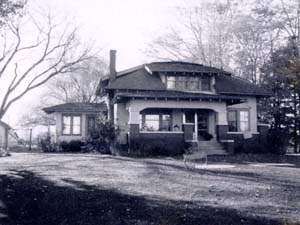- Look for original blueprints in your attic, basement, cupboards, etc. They usually specify the company's name, model number, and sometimes the draftsman's or architect's name or initial.
- If there are no blueprints, consider it unusual to find a mail order house in its original condition or floor plan. It may have been remodeled or original owners may have requested different features or customized the standard design.
- Take two photographs of your house (front views of the left and the right sides) to compare with published plans. Look at the roof type and height of your house. Consider the elevation, configuration, and dimensions of the floor plan and match these features with illustrations in pattern/or mail order books. Look at editions of plans 10 to 15 years before and after the construction of your house. People often waited many years to build.
- Look for numbered markings on joists and rafters where they are exposed in the attic or cellar. These marks were keyed to the blueprints. Aladdin marked its lumber with dimensions. For instance, when the plan called for a 2x8 that was 12'6" long, lumber in that size was simply selected from the pile of 2x8s. Other companies, particularly Sears, used an alternate system by labeling the lumber with a code number, not a length. There was a letter and number for each type of unit (all identically numbered pieces being the same). When laid out at the building site with the lumber arranged in organized piles, finding the pieces was very easy.
- Look for trade marks on bathroom and hardware fixtures and then compare them with the ones in the period catalogs. Mail order houses such as Sears often had everything from the same source.
- Look at original mortgage or purchase papers, building permits, utility company records (particularly those relating to water and sewer installations), and newspapers circa the building permit date. There are often articles about new homes being constructed; and there could be articles about builders erecting precut houses "on speculation" knowing that the Sears trademark was a selling point.
- Research past owners and/or neighbors of the house and contact them for information.
Bibliography
Bicknell, A.J. Bicknell's Victorian Buildings: Floor Plans and Elevations for 45 Houses and Other Structures. New York: Dover Pubs. Inc., 1980.
Century Architectural Co. Late Victorian Houses and Cottages: Floor Plans and Illustrations for 40 House Designs. New York: Dover Pubs. Inc., 1999.
Comstock, W.T., Victorian Domestic Architectural Plans and Details. New York: Dover Pubs. Inc., 1987.
J. D. Loizeaux Lumber Company. Classic Houses of the Twenties. Philadelphia: Athenaeum; New York: Dover, 1992.
Moss, Roger W. Victorian Exterior Decoration. New York, New York: Henry Holt & Company, 1992.
Mulliner Box and Planing Company. Turn of the Century Doors, Windows and Decorative Millwork: Mulliner Catalog of 1893. New York: Dover Pubs. Inc., 1995.
Peterson, Fred W. Homes in the Heartland. Lawrence, Kansas: University Press of Kansas, 1992.
Smeins, Linda E. Building an American Identity: Pattern Book Homes and Communities, 1870-1900. Walnut Creek, CA: AltaMira Press, c1999.
Stevenson, Katherine Cole. Houses By Mail: A Guide to Houses From Sears, Roebuck and Company. Washington, D.C.: Preservation Press, c1986.
Stickley, Gustav. Craftsman Homes: Architecture and Furnishings of the American Arts and Crafts Movement. New York: Dover Publications, 1979.
Woodward, George. Victorian City and Country Houses: Plans and Details. New York: Dover Pubs. Inc., 1996.
Old House Journal Corporation. Old House Journal. Numerous issues have articles on Mail Order Houses.
Internet Sites
Aladdin Homes
http://www.arts-crafts.com/archive/aladdin.shtml
Sears Roebuck Houses
http://www.searsmodernhomes.com/
Carlinville, Illinois Sears Kit Homes
http://www.searshomes.org/index.php/2011/01/15/carlinville-illinois-and-its-sears-homes
Trade Catalogs at the University of Delaware Library: House Construction and Furnishings
http://www.lib.udel.edu/ud/spec/exhibits/tradecat/3house.htm


